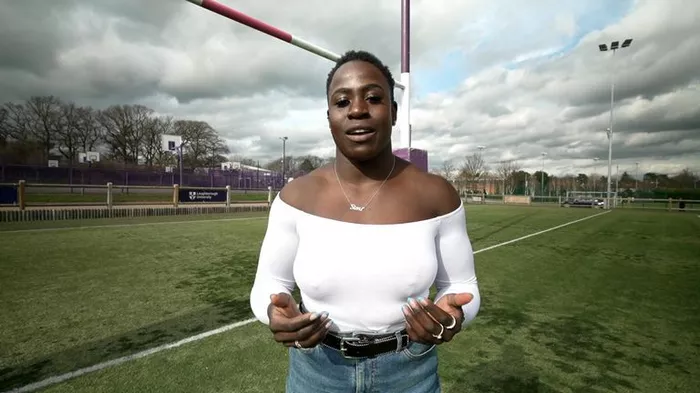Simi Pam, a junior doctor and semi-professional rugby player for Bristol Bears, has embarked on a thought-provoking journey to explore the intricate connection between sport, hair, and the experiences of Black women. Her personal quest began last October when she was compelled to cut off her afro hair due to the damage it incurred from her athletic lifestyle. This experience prompted Simi to delve into the question: Can hair act as a barrier for Black women when it comes to participating in sports and exercise?
In a report for Sky Sports News, Simi Pam crisscrossed the country, engaging with other Black sportswomen to uncover their experiences and insights on this significant issue. Her compelling narrative uncovers the profound significance of hair in the lives of Black women, transcending mere aesthetics.
The societal perception of natural afro-textured hair as ‘unruly,’ ‘unprofessional,’ or ‘unattractive’ is a pervasive issue for Black women, particularly in Western societies. These preconceived notions often lead to feelings of insecurity and discomfort in embracing one’s natural hair, adding complexity to the choice of hair styles.
The “Good Hair Study” by the Perception Institute in 2017 reported that one in three Black women felt that hair was a factor deterring them from participating in sports, a stark contrast to white women, where only one in 10 reported the same concerns.
Simi Pam, who was born in Nigeria and emigrated to the UK at a young age, combines her roles as a junior doctor in the NHS and a semi-professional rugby player. She brings a unique perspective as an elite athlete and a healthcare professional who has personally grappled with the challenges posed by her afro hair.
The struggle Black women face in reconciling societal standards of beauty with their natural hair is often intensified by popular culture and media. The prevalent practices of hair straightening, braids, weaves, and wigs frequently require significant manipulation and are time-consuming, costly, and labor-intensive. As a result, many Black women are reluctant to engage in activities, including sports and exercise, that could potentially jeopardize their chosen hairstyles.
In 2018, the British Beauty Council reported that Black British women spent six times more on haircare than their white counterparts, highlighting the substantial financial investment involved in maintaining these styles.
Simi Pam shared her personal experience of playing rugby with braids, which resulted in severe damage to her natural hair. The distress of seeing her hair broken and split within the strands, along with evidence of traction alopecia, led her to the life-altering decision to cut her hair in October 2022. This transformation marked the beginning of her journey toward self-acceptance and self-love.
The issue extends beyond personal experiences and anecdotes. Trichologist Eleanore Richardson, specializing in Black women’s hair and those of mixed heritage, explained that the damage occurs due to the continuous stress and tension exerted on the hair. Prolonged and tight hairstyles, coupled with the weight of hair accessories, contribute to conditions such as traction alopecia, a type of hair loss.
Simi Pam’s journey led her to engage with other Black athletes who grappled with similar challenges related to their hair. Tabby Stoecker, a Team GB Skelton and Bobsleigh athlete, shared the difficulty of protecting her hair in sports, noting that even protective styles such as plaits or braids are not immune to damage. Sadia Kabeya, a rugby player for Loughborough Lightning, highlighted the toll heavy braids took on her natural hair.
Reneeqa Bonner, Simi’s Bristol Bears teammate, disclosed the lengths to which hair-related concerns had affected her training, particularly during the winter months. Annie Tagoe, a world 4x100m bronze medalist, emphasized the importance of appearance in individual sports and how it affects sponsorship and following.
Jazmin Sawyers, European indoor long jump gold medalist, offered a fresh perspective on embracing change and minimizing concerns about hair damage. Her refreshing outlook challenges the stigma associated with hair appearance and encourages self-acceptance.
In collaboration with trichologist Eleanore Richardson, Simi Pam learned about the potential for hair regrowth and reversal of damage. However, it became clear that the issue of Black women’s hair in the Western world is multi-dimensional and complex.
The primary step toward addressing this challenge is creating an environment where Black women feel comfortable embracing and celebrating their natural hair. Simi Pam’s narrative underscores the significance of initiating discussions about natural hair and the damage incurred due to popular styling practices.
These discussions can pave the way for change, encouraging governing bodies to invest in initiatives promoting inclusivity within sports. Initiatives like Alice Dearing’s advocacy for the recognition of “Soul Caps,” designed to favor the inclusion of Black women with natural hair in elite swimming competitions, can make a difference.
In closing, Simi Pam passionately advocates for a cultural shift where Black women feel they are enough without hiding their natural hair, be it in the workplace, social settings, or on the sports field. She envisions a world where Black women can embrace their unique hair texture without compromise and judgment, ultimately breaking the barriers that hair can pose in the pursuit of sport and exercise.

